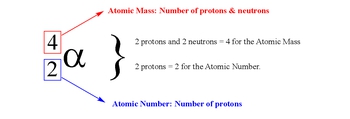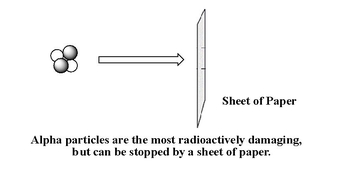Alpha decay is a type of radioactive decay where an unstable nucleus emits an alpha particle, which consists of 2 protons and 2 neutrons. This process results in a decrease in the atomic mass of the original element by 4 and the atomic number by 2. The alpha particle can be represented as:
\[\text{Alpha Particle} = \frac{4}{2} \text{He}\]
Here, Helium (He) is used to symbolize the alpha particle because it has the same atomic mass (4) and atomic number (2). In the context of alpha decay, the term "decay" indicates that the alpha particle is a product of the reaction.
For example, consider the isotope Polonium-210 (represented as Po with an atomic mass of 210 and an atomic number of 84). When Polonium-210 undergoes alpha decay, it emits an alpha particle:
\[\text{Po}_{84}^{210} \rightarrow \text{He}_{2}^{4} + \text{Pb}_{82}^{206}\]
In this reaction, the total atomic mass must be conserved. The original atomic mass of Polonium-210 is 210, and after emitting the alpha particle (mass 4), the remaining mass must be 206. This leads to the formation of Lead-206 (Pb), which has an atomic number of 82. Thus, the alpha decay of Polonium-210 results in the creation of Lead-206, while the emitted alpha particle is considered waste.
It is essential to ensure that both the atomic mass and atomic numbers balance on both sides of the equation, confirming the conservation of mass and charge in nuclear reactions.




